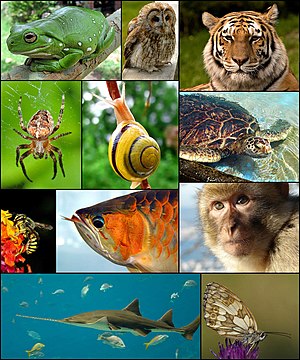좌우대칭동물
좌우대칭동물(Bilateria)은 방사대칭동물과 달리 좌우대칭의 형태를 가진 동물의 분류군이다. 배아처럼 좌우 대칭을 이루는 동물이다. 즉, 왼쪽과 오른쪽이 서로 거울상을 가진다. 이것은 또한 머리와 꼬리(전후 축)뿐만 아니라 배와 등(배-등 축)을 가지고 있음을 의미한다.[1]
|
| ||
|---|---|---|
 좌우대칭동물의 다양성 | ||
| 생물 분류ℹ️ | ||
| 역: | 진핵생물 | |
| 계: | 동물계 | |
| 아계: | 진정후생동물아계 | |
| (미분류): | 좌우대칭동물(Bilateria) Hatschek, 1888 | |
| 문 | ||
| ||
특징
편집초기의 좌우대칭동물 중 일부는 벌레처럼 생겼었고 좌우대칭동물의 몸은 입과 항문, 그리고 두 구멍 사이를 잇는 내장을 가진 원통으로 표현될 수 있다. 내장 주위에는 내부 체강이나 체강또는 유사 체강이 있다. 좌우 대칭 신체 평면을 가진 동물들은 앞, 뒤, 그리고 등과 배를 가지고 있다. 좌대칭동물 또한 좌, 우가 구분되어 있다.
좌우대칭동물에게 앞 뒤가 구분되어 있다는 것은 머리가 입, 두부화(cephalisation), 감각 기관과 머리의 발달과 같은 자극을 만난다는 것을 의미한다. 몸은 머리에서 뒤로 뻗어 있고, 많은 좌우대칭동물들은 몸을 수축시키는 원형 근육들과 몸을 이완하는 근육들의 조합을 가지고 있는데, 이 유체정역학적인 골격을 가진 부드러운 몸을 가진 동물들이 연동 운동에 의해 움직일 수 있게 한다. 대부분의 좌우대칭동은 입에서 항문까지 몸을 통해 뻗어 있는 내장을 가지고 있는 반면, 진무체강형동물은 하나의 개구가 있는 주머니 내장을 가지고 있다. 많은 좌우대칭동물은 섬모와 함께 헤엄치고 감각 세포를 포함하는 정점 기관을 가진 원발성 유충을 가지고 있다. 그러나 이러한 각 특성에는 예외가 있다. 예를 들어 성충 극피동물은 유충과 달리 방사대칭이며 특정 기생충은 매우 다형성적인 신체 구조를 가지고 있다.
계통 분류
편집다음은 동물의 계통 분류이다.[2][3][4][5][6]
| 동물 |
| ||||||||||||||||||||||||||||||||||||||||||||||||||||||||||||||||||||||||||||||||||||
각주
편집- ↑ Brusca, Richard C. (2016). 〈Introduction to the Bilateria and the Phylum Xenacoelomorpha: Triploblasty and Bilateral Symmetry Provide New Avenues for Animal Radiation〉 (PDF). 《Invertebrates》. Sinauer Associates. 345–372쪽. ISBN 978-1-60535-375-3.
- ↑ Peterson, Kevin J.; Cotton, James A.; Gehling, James G.; Pisani, Davide (2008년 4월 27일). “The Ediacaran emergence of bilaterians: congruence between the genetic and the geological fossil records”. 《Philosophical Transactions of the Royal Society of London B: Biological Sciences》 363 (1496): 1435–1443. doi:10.1098/rstb.2007.2233. PMC 2614224. PMID 18192191.
- ↑ Parfrey, Laura Wegener; Lahr, Daniel J.G.; Knoll, Andrew H.; Katz, Laura A. (2011년 8월 16일). “Estimating the timing of early eukaryotic diversification with multigene molecular clocks”. 《Proceedings of the National Academy of Sciences》 108 (33): 13624–13629. Bibcode:2011PNAS..10813624P. doi:10.1073/pnas.1110633108. PMC 3158185. PMID 21810989.
- ↑ “Raising the Standard in Fossil Calibration”. 《Fossil Calibration Database》. 2018년 3월 7일에 보존된 문서. 2018년 3월 3일에 확인함.
- ↑ Laumer, Christopher E.; Gruber-Vodicka, Harald; Hadfield, Michael G.; Pearse, Vicki B.; Riesgo, Ana; Marioni, John C.; Giribet, Gonzalo (2018). “Support for a clade of Placozoa and Cnidaria in genes with minimal compositional bias”. 《eLife》. 2018;7: e36278. doi:10.7554/eLife.36278. PMC 6277202. PMID 30373720.
- ↑ Adl, Sina M.; Bass, David; Lane, Christopher E.; Lukeš, Julius; Schoch, Conrad L.; Smirnov, Alexey; Agatha, Sabine; Berney, Cedric; Brown, Matthew W. (2018). “Revisions to the Classification, Nomenclature, and Diversity of Eukaryotes”. 《Journal of Eukaryotic Microbiology》 66 (1): 4–119. doi:10.1111/jeu.12691. PMC 6492006. PMID 30257078.
외부 링크
편집- 위키생물종에 Bilateria 관련 자료가 있습니다.
| 이 글은 동물에 관한 토막글입니다. 여러분의 지식으로 알차게 문서를 완성해 갑시다. |